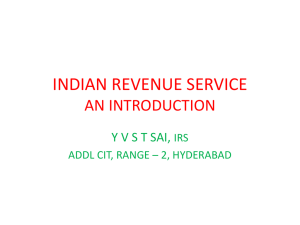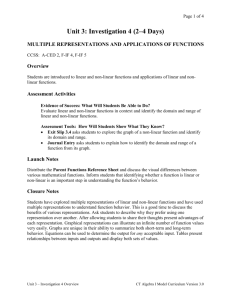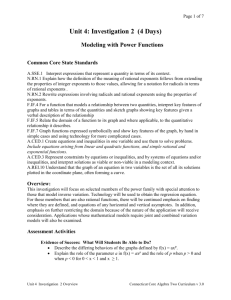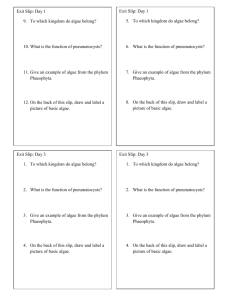Overview - Connecticut Core Standards
advertisement
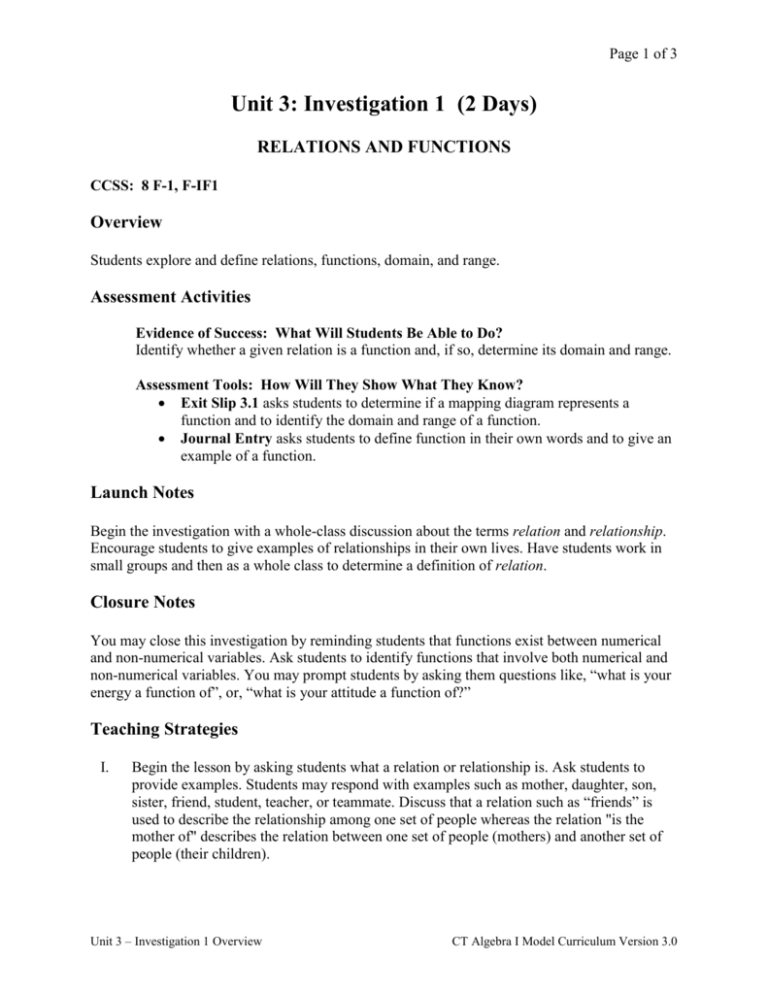
Page 1 of 3 Unit 3: Investigation 1 (2 Days) RELATIONS AND FUNCTIONS CCSS: 8 F-1, F-IF1 Overview Students explore and define relations, functions, domain, and range. Assessment Activities Evidence of Success: What Will Students Be Able to Do? Identify whether a given relation is a function and, if so, determine its domain and range. Assessment Tools: How Will They Show What They Know? Exit Slip 3.1 asks students to determine if a mapping diagram represents a function and to identify the domain and range of a function. Journal Entry asks students to define function in their own words and to give an example of a function. Launch Notes Begin the investigation with a whole-class discussion about the terms relation and relationship. Encourage students to give examples of relationships in their own lives. Have students work in small groups and then as a whole class to determine a definition of relation. Closure Notes You may close this investigation by reminding students that functions exist between numerical and non-numerical variables. Ask students to identify functions that involve both numerical and non-numerical variables. You may prompt students by asking them questions like, “what is your energy a function of”, or, “what is your attitude a function of?” Teaching Strategies I. Begin the lesson by asking students what a relation or relationship is. Ask students to provide examples. Students may respond with examples such as mother, daughter, son, sister, friend, student, teacher, or teammate. Discuss that a relation such as “friends” is used to describe the relationship among one set of people whereas the relation "is the mother of" describes the relation between one set of people (mothers) and another set of people (their children). Unit 3 – Investigation 1 Overview CT Algebra I Model Curriculum Version 3.0 Page 2 of 3 Differentiated Instruction (For Learners Needing More Help) Use Venn diagrams to introduce the discussion about relations. One diagram shows a group of friends, another a group of mothers, and a third a group of children. Later you can show the relationship between the children and their mothers as a mapping diagram. Have students work in pairs to define the word relation. Ask students to share their definitions with the class and then to agree on a definition as a class. Explain that relations can be expressed in at least five different ways: mapping diagrams, tables, ordered pairs, graphs, and equations. However, not all relations lend themselves to being expressed using all five methods. This is an opportunity for you to choose examples in which your students will be most interested. Students should include an example of each representation in their notes. Additionally, you should define input and output. Some ideas are listed below: Mapping Diagram — Map each member of a family to each of their phone numbers, map eight of your students to their English teachers, map eight of your students to the number of siblings they have Table — Display New England states and their capitals or football quarterbacks and their highest number of completed passes in a game Ordered Pair — Show famous people and the sports they play Graph — Plot the number of gallons of fuel used compared to the distance the car has traveled (use the mpg of a car your students like), or display the graph of the high temperature in your town over the last week or the graph of stock price of a local company over time Equation — Show the formula that converts Celsius to Fahrenheit or use another formula that students are currently learning about in science class Group Activity Form groups of four. Have students work in pairs to find three different relations and represent each one a different way. Then swap papers with the other pair. Now represent each of the three relations given to you with a second representation. (For example, if you are given a table, you may make a mapping diagram or a list of ordered pairs.) Activity 3.1.1a or 3.1.1b may be used in class or for homework. These activities allow students to explore the five different representations. You may want to wait on question #9 until the class has discussed the definition of function. If one activity is used in class, the other may be assigned for homework. Unit 3 – Investigation 1 Overview CT Algebra I Model Curriculum Version 3.0 Page 3 of 3 Differentiated Instruction (Enrichment) Have students use the Internet to research the definition of the word function in mathematics. They should obtain a definition from at least three websites and bring the definitions and each source to class the next day. Students may share their definitions in small groups and then write a definition in their own words to share with the class. II. Discuss the concept of a function with the class. Post the definition of a function on the bulletin board. Go back to the examples of relations and have the students identify which relations are functions and explain their reasoning. Depending on the examples you used and any additional examples students describe, you may have the opportunity to discuss the Vertical Line Test. Introduce students to the terminology of domain and range. Have students identify the domain and range of each function. Use set notation to list values and inequalities where appropriate. However, do not insist that students use set builder notation if they prefer to give an accurate verbal description. You may choose to do a few examples as a full class and then have students work together in pairs. Discuss the relationship among the vocabulary words domain, independent variable, and input and between range, dependent variable, and output. Activity 3.1.2 Is It a Function can be used in class or for homework. Following this activity, students should complete Exit Slip 3.1 where they are asked to identify a function and its domain and range. Journal Entry Use your own words to define a function. Give an example of a function and explain why it is a function. Differentiated Instruction (Enrichment) Have students find data about a relationship they are interested in. For example, pounds of fish eaten by individual sea lions at Mystic Aquarium. Use the internet to find data. Identify the domain and range for the relationship. Resources and Materials Activity 3.1.1a – Representing Relations I Activity 3.1.1b – Representing Relations II Activity 3.1.2 – Is It a Function Exit Slip 3.1 – Identify the Function Bulletin Board for key concepts Student Journals Unit 3 – Investigation 1 Overview CT Algebra I Model Curriculum Version 3.0







